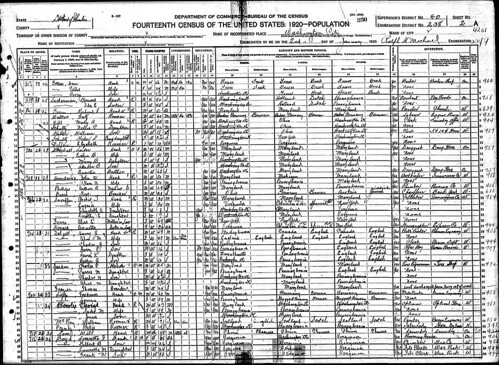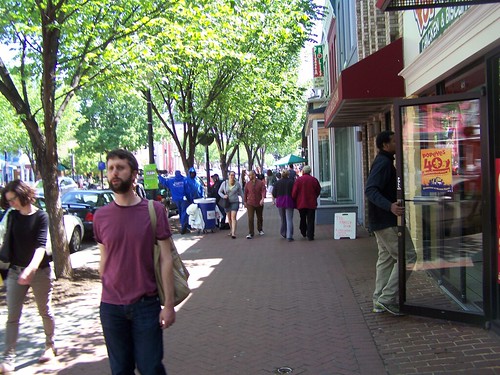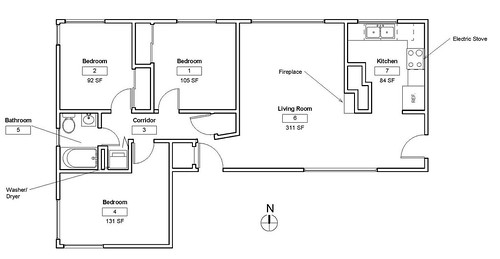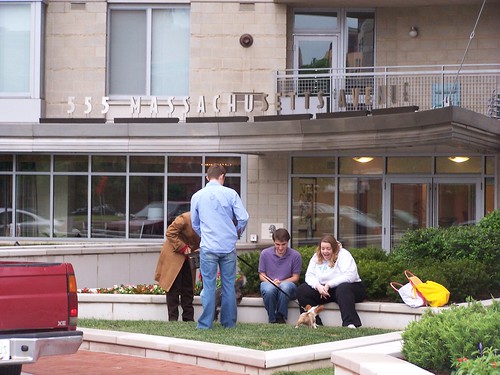Back to the future: extended families as a re-emerging housing trend?

1920 Census enumeration sheet showing much larger household sizes than are typical today, H and 9th Streets NE, Washington, DC
-- crossposted, eventually, at the National Housing Institute Rooflines blog
Living in Washington, DC, it's very difficult to generalize about housing issues, because despite the fact that the country's real estate troubles in terms of foreclosures hasn't skpped over the region, the fact is that generally, the Washington region, and in particular the core of the center city, and the inner ring suburbs in Alexandria, Arlington, and Montgomery Counties have maintained their value (Prince George's County communities have gotten crushed by foreclosures, and this has even impacted communities along Rte. 1 including Mount Rainier and Hyattsville--e.g., my business partner's house in Mt. Rainier would easily be worth between 2x and 5x more than it is were it located in DC).
The market here for new single family housing may be somewhat depressed, but apartment construction is going like gangbusters, and there is even some condominium development, although financing requirements are particularly onerous. Although there is no question that as the federal government slakes off on expansionary tendencies, the market will not be booming going forward.
Even so, out last Sunday in the Capitol Hill neighborhood, I was astounded to see so many people out and about on 8th Street SE (Barracks Row) and at Eastern Market, because 5 years ago, Barracks Row was a daytime ghost town every day of the week, even weekends.

FACTORS CONTRIBUTING TO INCREASES IN HOUSEHOLD SIZE
• Unemployment (and other economic reversals) has led to adult children returning home to live, increasing housing size and reducing demand for housing: ("One Roof, Three Generations, Many Decisions" from National Public Radio) even though the number of singleton households continues to rise ("More singles living alone and loving it, despite the economy" from USA Today). This is a leading cause of the continued weakness in the housing market.
As David Smith of Recap Real Estate Advisors and the Affordable Housing Institute said in his Guru column, "What should we be preserving?," last June:
Last year, for the first time in fifty years, American average household size rose, to perhaps 2.65 people. With 307,000,000 Americans, households of 2.59 people need 118,500,000 dwellings, whereas households of 2.65 people need 115,850,000 dwellings. At a demographic stroke, this means reduced effective demand for 2,650,000 homes – more than two years’ total national housing production.
Where did the households go? Back into hibernation, by doubling and tripling up or moving back home – today roughly 30% of all young adults live with their parents, and for one principal reason: jobs. They can't afford to be independent.
Housing fails if communities fail, and communities fail if jobs fail. ...
Average Household Size over the Decades (US Census data)
- 1900
- 1910
- 1920
- 1930
- 1940
- 1950
- 1960
- 1970
- 1980
- 1990
- 2000
- 4.60
- 4.54
- 4.34
- 4.01
- 3.68
- 3.38
- 3.29
- 3.11
- 2.75
- 2.63
- 2.59
• Middle class wages continue to drop, especially because of the globalization of the labor market: while economist Paul Krugman makes this point often in his columns in the New York Times, I was really struck by Elliot Spitzer's mentioning of this at his presentation at the recent ULI Washington Real Estate Trends conference ("ULI Washington 2012 Real Estate Trends Conference #1: Elliot Spitzer"). This furthers the "doubling up" trend.
• Rents are rising: because people leaving the owner-occupied housing market need a place to live. This furthers the "doubling up" trend.
• New credit guidelines in the mortgage market make it much harder to buy (or refinance) a house. During the real estate bubble, I came up with my only decent joke, that "polygamy is going to be legalized, because you need at least three incomes to buy a house." Will this have an impact on household size?
These kinds of dynamic may mean that the old way of extended families--parents, grandparents, children, adult children--living under one roof may be returning
This has major implications for market rate and social housing production going forward, if it is a real trend, especially in weak market metropolitan areas.
POLICY AND PLANNING IMPLICATIONS
1. It means we need more apartments with more bedrooms.
Production in multiunit residential housing of units with 3 or more bedrooms is minimal. Most market rate buildings, except for superpremium properties, tend to focus their production 55% on studios/efficiencies and 1-bedrooms and 45% 2-bedrooms, although as much as 5% of the units can be 3-bedrooms, depending on the market.

A typical 3-bedroom apartment layout has a shared living and dining room and no additional family spaces, other than bedrooms.
HopeVI rebuilds of social housing projects tend to significantly reduce the inventory of larger apartments, and the tenancy of multi-generational families is often seen as problematic.
Housing elements in comprehensive land use plans will need to be adjusted so that they provide guidance for the provision of such housing, and incentive packages probably need to be developed to assist in the provision of a larger inventory of larger apartments than would normally be provided.
2. It means that greater attention needs to be made to the provision of outdoor public spaces, civic spaces, and commercial spaces. And community planning processes need to be updated to ensure that these types of spaces are provided.
As households become larger, more people will spend more time out-of-the-home on social activities, "to get away" from the house and the cramped quarters. Parks and other public places, recreation spaces, active streets in commercial districts, and other places may become increasingly in demand as households become larger and multi-generational. Too often, community land use practices haven't caught up to these changing circumstances as more people live in city centers.

This was discussed in the entry "Park Service, Wells helping downtown get a playground" in GGW, although I will point out that I made similar points about the need to plan for recreational space downtown in blog entries and writings over the years. The Zoning Commission ruled that downtown housing projects didn't have to provide recreational space, but at the same time, they didn't require that such projects pay into a fund to be used to pay for the creation of shared recreational spaces.
Planning protocols need to be checked and updated to account for the need for these kinds of spaces.
-- Buckhead Collection public space plan, Atlanta
3. Indoor community spaces within multi-unit residential complexes need attention too.
Increasingly, higher end properties are providing high quality on-site amenities ranging from business centers, wi-fi, television projection rooms, outdoor kitchens and patios, fitness facilities, etc.
From the standpoint of addressing "social exclusion" through the provision of high quality programs and practices of "social inclusion," we need to ensure that social housing developments have high quality on-site amenities also.
The THEARC (Town Hall Education and Arts Campus) was created by the William Smith Companies as part of their rebuilding of various housing projects in Ward 8 in Washington, DC. While not an on-site amenity building per se, it's an example of creative and innovative thinking about the provision of amenities and community spaces in social housing.
4. US social housing development policies need to change too, to adapt to these changing circumstances. While the HOPEVI program changed social housing polices to change public housing communities so that they now can and do incorporate residents with a mix of incomes, policies haven't changed to allow the inclusion of retail and commercial space into these projects.
Trends for mixed use development shouldn't bypass social housing, especially because "commerce is the engine of urbanism" and is one of the crucial forms of exchange that support community as well as build and extend it. And profits made on commercial space can support the provision of other programs.
Labels: demographics, housing choice, housing market, housing policy, multi-unit housing, provision of public services, urban revitalization



0 Comments:
Post a Comment
<< Home